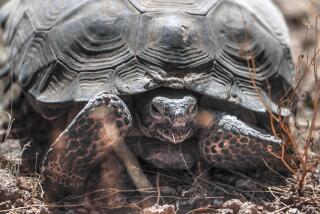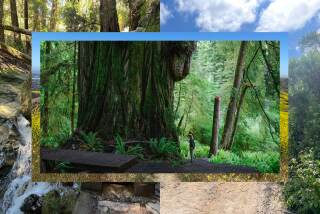Counting Bighorn Sheep in a Desert of Mountains
- Share via
Geologists often call the eastern Mojave a desert of mountains. The most prominent of these are the chains that trend southwest-northeast across Mojave National Preserve, a high-profile combination formed by the Granite, Providence, Mid-Hill and New York ranges.
The Granite Mountains, southernmost in the chain, are a little-visited wilderness, the domain of desert bighorn sheep. In fact, the craggy shoulders of these 6,000-foot mountains are favored haunts of the elusive creatures. A lack of asphalt (the sheep don’t like to step on paved roads) and scarce human activity in this southern corner of the preserve create a bighorn-friendly environment.
The rugged Granite Mountains and the other granite ranges in the eastern Mojave have been highly eroded; characteristic of erosion is the buildup of loose sedimentary materials at the base of the mountains, apron-shaped formations called alluvial fans.
At 6,365 feet, Silver Peak is not the highest summit in the Granite Mountains (that honor belongs to Granite Mountain, the 6,762-foot signature summit a few miles south of Silver Peak), but it does boast the only decent trail in the range, the Granite Mountain Trail. The reward for the steep climb to Silver Peak is vistas of some of Mojave National Preserve’s most prominent features, including Cima Dome, the Providence Mountains and Kelso Dunes.
Hikers seeking a more modest exploration of the Granite Mountains could hike through Cottonwood Wash two miles or so and turn around before the going gets really steep.
Portions of these mountains are part of the University of California’s Granite Mountains Natural Reserve. Such reserves represent a variety of the state’s ecosystems, including Big Sur, the Eel River and a dozen more. They are dedicated to ecological research and education and typically serve as outdoor classrooms and field laboratories for students and faculty.
About 9,000 acres in the Granite Mountains are in the UC reserve, of which 2,500 acres are owned by the University of California.
To avoid disturbing the natural sciences research projects conducted in the Granite Mountains, please heed the reserve’s “No Trespassing” signs and stay on the area’s main trails.
The rapid change in elevation along Silver Peak Trail is accompanied by distinct changes in vegetation. At lower elevations in Cottonwood Wash, sage and yucca are among the dominant plants. Higher elevations bring cholla-dotted slopes and a woodland of pin~on pine and juniper.
Directions to trail head: From Interstate 40, about 78 miles east of Barstow and 65 miles west of Needles, exit on Kelbaker Road and head north into Mojave National Preserve.
Ten miles from I-40, look left (west) for an unsigned dirt road. (Clue: Another dirt road, nearly opposite this one, heads east from the other side of Kelbaker Road.) Those traveling from northern preserve locations on Kelbaker Road will find the above-mentioned turnoff about 4.6 miles south of the turnoff for Kelso Dunes.
Drive 1.75 miles to a small rise, where there is a camping area (no facilities) and the signed boundary of the wilderness.
The hike: Head west into Cottonwood Wash. After 0.1 mile, the road forks. Stay right and hike up the wash. Reminders of the area’s ranching days come in the form of fencing and dirt tracks leading off to water tanks and corrals.
After about 1.25 miles, the old road narrows to a trail and begins an aggressive ascent up Silver Peak. The steep path passes amid pin~on pine and juniper. A bit more than three miles out, the trail angles west for 0.5 mile, then north again.
The path ends 0.25 mile and about 300 feet in elevation short of the summit. Cairns help guide you over a steep, rocky slope to the summit.
Granite Mountain Trail
Where: Granite Mountains
Distance: Through Cottonwood Wash is 4 miles round trip; to Silver Peak is 8.5 miles round trip with 2,400 foot elevation gain.
Terrain: Aptly named Granite Mountains, pinyon pine-juniper woodland.
Highlights: Big horn sheep domain, terrific preserve panoramas.
Degree of difficulty: Moderate to strenuous.
Precautions: Access road to trail is narrow, rough, brush-crowded, and hard-to-spot.
For more information: Mojave Desert Baker Information Center; tel. (760) 733-4040 or Mojave National Preserve Headquarters; tel. (760) 255-8801.
More to Read
Sign up for The Wild
We’ll help you find the best places to hike, bike and run, as well as the perfect silent spots for meditation and yoga.
You may occasionally receive promotional content from the Los Angeles Times.






